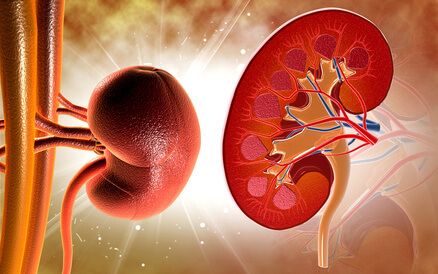According to this meta-analysis, soon to be published in Eur. J. Vasc. Endovasc. Surg., endovascular abdominal aortic aneurysm repair prostheses with suprarenal fixation do not alter significantly the glomerular filtration rate at one year from device implantation. However, we should acknowledge that long-term outcomes are still unknown. The literature is inconsistent as regards the definition of renal dysfunction. In consequence, we will have to settle for this meta-analysis and some speculation, both of which result in more questions than answers.
 Endovascular infrarenal abdominal aortic aneurysm repair is currently the standard of care. Many devices available in the market offer suprarenal fixation, aimed at improving prosthesis anchoring and preventing migration (a common occurrence when this technique was first introduced). However, we have not really wondered whether this could affect glomerular filtration in the medium and long term.
Endovascular infrarenal abdominal aortic aneurysm repair is currently the standard of care. Many devices available in the market offer suprarenal fixation, aimed at improving prosthesis anchoring and preventing migration (a common occurrence when this technique was first introduced). However, we have not really wondered whether this could affect glomerular filtration in the medium and long term.
This work identified 24 studies on the subject and a meta-analysis was used to assess glomerular filtration rate drop at 1 and 5 years from device implantation.
Read also: Constrictive Pericarditis After Pericardiocentesis.
The primary endpoint was a glomerular filtration rate drop >20% at 1 year, a glomerular filtration rate drop >20% at 5 years, or “renal dysfunction” based on the definition used in each publication.
Among all studies considered, 5 reported glomerular filtration reduction >20%; the odds ratio (OR) was 1.53 (9.3% for suprarenal fixation devices versus 7.4% for non-suprarenal-fixation devices). One of these studies reported this event at 5 years with an OR = 1.77 (16.9% with suprarenal fixation vs. 10.3% without suprarenal fixation; p = 0.03).
Read also: Stroke, Migraine and Patent Foramen Ovale Not Necessarily Temporary Associated.
“Renal dysfunction” definitions varied greatly among studies; in consequence, it was not useful as a point of comparison for differences as regards the addressed event.
Conclusion
Endovascular abdominal aortic aneurysm repair prostheses with suprarenal fixation do not seem to alter glomerular filtration rates at one year from the procedure, and long-term results are limited. Unfortunately, arbitrary definitions of renal dysfunction are too common in the literature, thus precluding further conclusions.
Original title: The Impact of Suprarenal Fixation on Renal Function Following Endovascular Abdominal Aortic Aneurysm Repair: Meta-Analysis Based on Estimated Glomerular Filtration Rate.
Reference: T. Calderbank et al. Eur J Vasc Endovasc Surg (2018). Article in press.
Get the latest scientific articles on interventional cardiologySubscribe to our weekly newsletter
We are interested in your opinion. Please, leave your comments, thoughts, questions, etc., below. They will be most welcome.





